The Limits of the Earth — Part 2: Expanding the Limits
April 19, 2013 by Ramez Naam
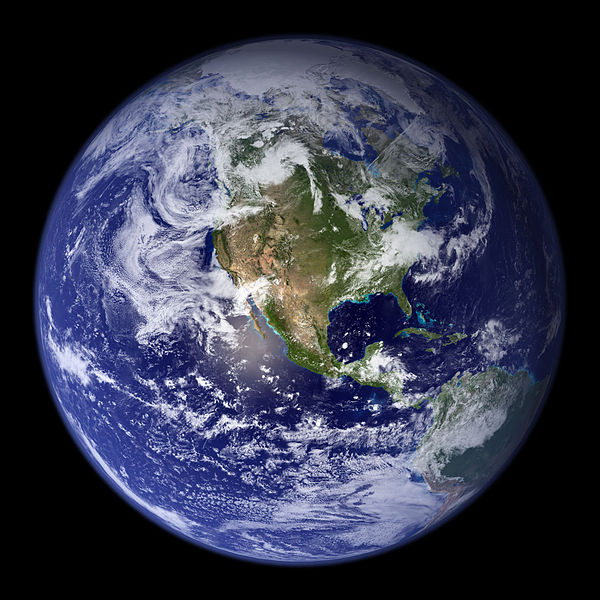
(Credit: NASA)
This is part two of a two-part series on the limits of human economic growth on planet Earth. Part one details some of the environmental and natural resource challenges we’re up against. Part two, here, looks at the ultimate size of the resource pool and solutions to our problems. Both parts are based on Ramez Naam’s new book, The Infinite Resource: The Power of Ideas on a Finite Planet
The Solution: Growing the Pie
As part one of this series showed, we are up against incredible challenges: feeding a world with a rapidly growing appetite, the continuing loss of the world’s precious forests, the ongoing collapse of fish species in the oceans, the rapid depletion of our fresh water resources, and the over-arching threat of climate change, which makes all others far worse.
Ending growth isn’t a realistic option. Billions of people in the developing world want access to more resources,deserve those resources as much as those of us in the rich world do, and need them in order to rise out of poverty. Growth won’t end without a struggle. And that struggle could turn violent, as it has in the past.
There’s only one acceptable way out of our current predicament. And that is to grow the total pie of resources available to the world’s inhabitants. And a close look at the numbers and at the human history of innovation suggests this is possible.
Food
No resource has driven more discussion of impending limits to growth than food. Malthus — the original proponent of a near term limit to growth — wrote in the late 18th century that population would always grow exponentially, while food production could at best grow linearly. Thus, humanity was doomed to remain in what we now refer to as the Malthusian Trap.
More recently, in 1968, environmentalist Paul Ehrlich opened his best seller The Population Bomb with the lines. “The battle to feed humanity is over. In the 1970s the world will undergo famines — hundreds of millions of people are going to starve to death in spite of any crash programs embarked upon now. At this late date, nothing can prevent a substantial increase in the world death rate.”
Both Malthus and Ehrlich were wrong. Population did expand, but so did food production. Since Ehrlich wrote The Population Bomb, the population has doubled and death rates have declined. Food yields — the amount grown per acre — have nearly tripled. That increase in food yields has been driven by new seeds, better farming methods, and increased availability of fertilizer and pesticides.
But increasing yields aren’t anything new. The yield growth since the 1960s has been dramatic, but it’s part of a process that’s been going on for more than 10,000 years. In pre-historic times, it took perhaps 3,000 acres of land to feed one hunter gatherer. Today it takes about 1/3 of one acre to feed the average person on earth. We’ve increased the amount of food grown per acre by a factor of 10,000 in 10,000 years.
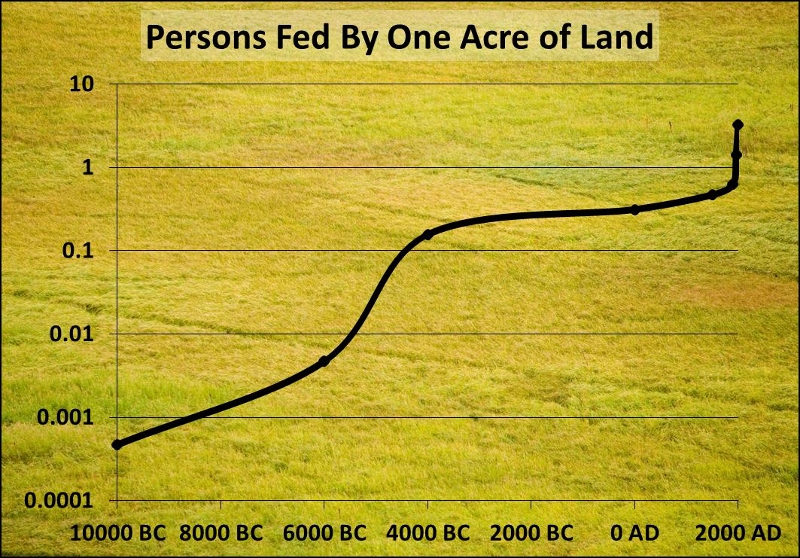
Since pre-history, humans have increased the food output of an acre of land by a factor of 10,000. See The Infinite Resource: Power of Ideas on a Finite Planet for full data sources involved in this graph.
Even with this tremendous surge in food yields, we know that there’s headroom. Current farms convert less than 0.1% of the solar energy that strikes them into calories consumable by humans. The theoretical limit of photosynthesis is around 13% conversion of sunlight into calories. We may never reach that theoretical limit, but even if we could reach, say, 3% conversion, we would be growing thirty times as much food per acre as we are now, enough to feed a population far larger than humanity is ever projected to reach.
Closer to the present, there are more practical and specific reasons to believe that feeding the world is possible. Today, global grain yields average around 3.5 tons per hectare. In the US, they average around 7 tons per hectare. That difference in yield primarily reflects more access to capital and energy. US farmers (and farmers in other rich countries) can afford fertilizer, mechanized farm equipment, irrigation systems, pesticides, and other tools that boost agricultural yields. Bringing developing world farmers access to the same tools would boost yields as well, potentially doubling them, which is more than the 70% increase the FAO believes is required by 2050. Indeed, the best farms in the US routinely get double the US average yield, so even this level is far from the maximum achievable.
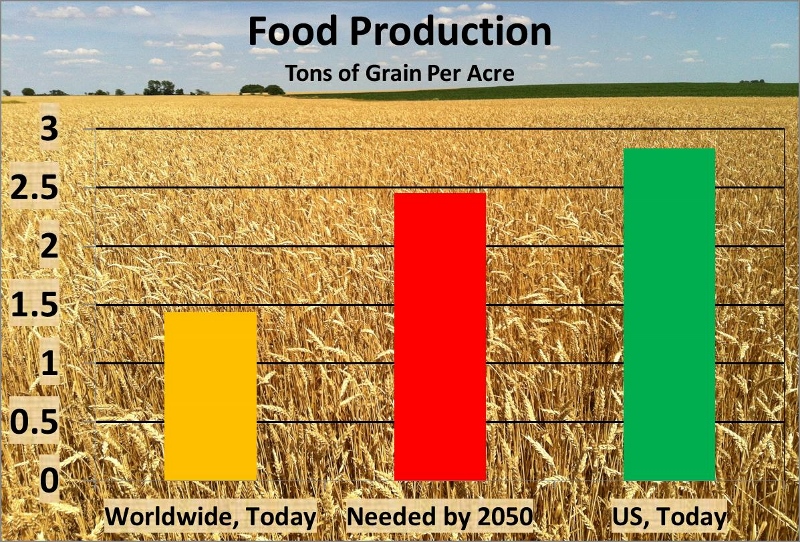
Food yields in the US and other developed nations are twice those of the world as a whole. If the world as a whole had food yields similar to those of the US, we would already have sufficient food production to meet the demand expected by 2050. Source: FAO
There may be other, less capital-and energy intensive routes as well. The yield gains over the last half century have come primarily from better seeds. And we know that further gains by seed improvements are possible. One intriguing possibility is to upgrade the photosynthesis pathways in wheat, rice, and millet. Those staple crops use C3 photosynthesis. Corn and sugarcane, on the other hand, use a newer photosynthetic pathway called C4. And as a result, Corn yields about 70% more grain per acre than wheat or rice. The Gates Foundation and other non-profits are working on ways to integrate C4 genes into rice and wheat now.
What of fertilizer? Nitrogen fertilizer is made from natural gas today, in a process that gives off greenhouse gases. Multiple groups, however, have shown that fertilizer can be synthesized from wind power and nitrogen in the air (where it makes up 78% of the atmosphere). An even more radical approach would be to borrow a trick from legumes. Soy and other legumes fertilize themselves (with help from symbiotic bacteria) by pulling nitrogen from the atmosphere themselves. Early stage projects funded by the Gates Foundation and elsewhere are evaluating whether wheat, corn, rice, and other cereals could be engineered to fertilize themselves from the air in the same way, reducing both the need to apply artificial fertilizer, and the nitrogen runoff that results from it.
Advances in how we produce food could also have a substantial impact on our overfishing of the seas. Wild fish are under threat of extinction because they’re hunted to feed us. Yet land animals that we farm are under no threat of extinction. Shifting from hunting fish to farming fish — where the farmers have the incentive to keep their stocks healthy — could do a tremendous amount of good for wild fish. Over the last few decades, the tonnage of fish farmed has soared, even as the tonnage of fish caught from the wild has stayed stagnant.
Advances in sustainable fish farming could take this even further, creating fish farms that are cleaner and better for the oceans around them, while able to produce protein far more efficiently than land animals, and removing the threat of extinction from wild fish.
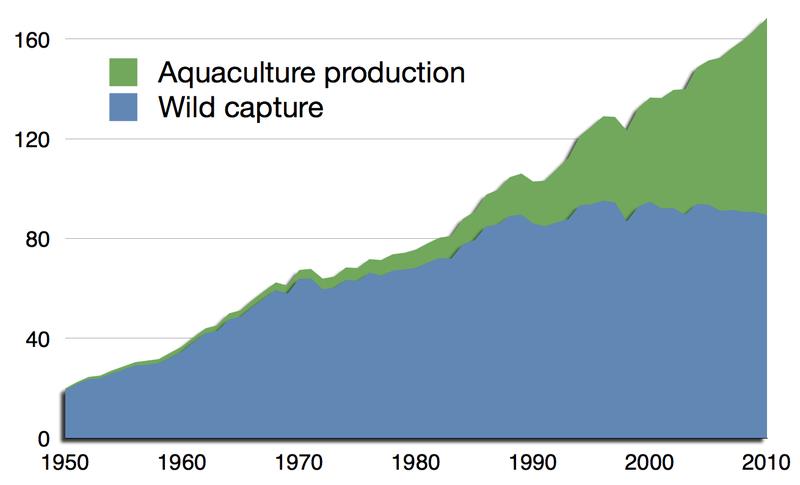
Wild fish catch has stagnated since the 1990s, as declining wild fish populations have made it harder and harder to bring fish in. Meanwhile, aquaculture (farmed fish) has boomed to take up the slack. Source: FAO
In short, the planet’s ultimate limit on food production is many times higher than our projected needs.
That, in turn, leads to an even more intriguing possibility. If we could raise food yields faster than demand, could we shrink the amount of land we use to farm? For instance, between now and 2100, total food demand may roughly double (driven more by increasing meat consumption than by population). If, in that timeframe, we could triple farm yields, then we could, potentially, grow all the food necessary to meet demand only two thirds of the land area used today.
That, in turn, would free up roughly 10% of the world’s land area, which could be returned to wilderness, to managed forest, or some other use. Whether or not we’d do this depends on an enormous number of factors. Humanity may or may not decide to reforest the planet or return land to wilderness. But if we innovate fast enough in lifting crop yields, we would have the option.
Water
We live on a water world. 70% of the world’s surface is covered in water. Yet the vast majority of that water — around 97% of it — is salt water. Another 2% is locked up in ice caps and glaciers. Only around 1% of the world’s water is fresh, and of that, humanity can only easily access about a tenth, or 0.1%.
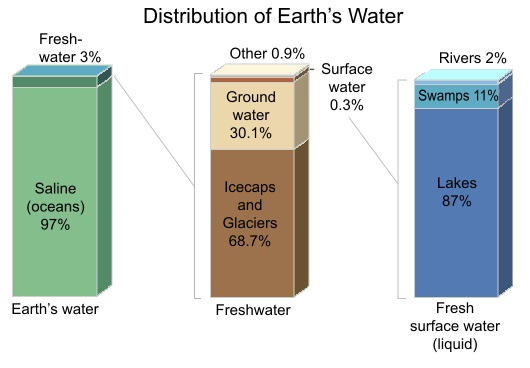
Humans access only a tiny fraction of the Earth’s available water. Most of the rest is salt water. Source: USGS.
If we could efficiently convert salt water to fresh, we’d have access to a vast supply of water to use in growing crops and sustaining human civilization. For decades, desalination has been considered a deeply anti-environmental process, though. It’s energy intensive. As a result, it releases huge amounts of greenhouse gases. Any attempt to increase fresh water access through desalination would have environmental consequences too dire to make the process worthwhile.
That view is out of date. From the time of the ancient Greeks through the late 1960s, desalination technology barely changed at all: boil water, capture steam, let the steam condense into fresh water. That process is incredibly energy intensive.
In the late 60s, however, two scientists at UCLA set out to see if they could mimic a feature of the biological membranes around cells. Cell membranes are selectively permeable. They can allow water and some molecules to pass through them while blocking out others. The resulting discoveries by Stanley Loeb and Srinivasa Sourirajan set off a long sequence of innovations in desalination using semi-permeable membranes. As a result, the energy needed to desalinate a gallon of water has fallen by a nearly factor of 10 since 1970.
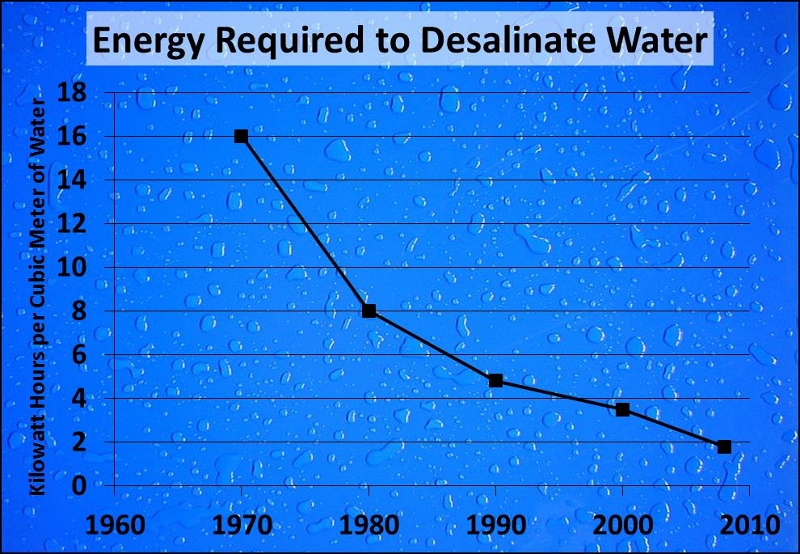
The amount of energy required to desalinate water has dropped by nearly a factor of 10 since 1970. Source: Menachem and Elimelech, “The Future of Seawater Desalination,” Science (2011)
The process is sufficiently cheap now that modern plants sell desalinated water at around 5 gallons per penny, or 500 gallons per US dollar. That is still too expensive for bulk use in agriculture, but it’s approaching the price where large scale desalination becomes truly feasible.
Of course, many dry areas are also inland, but the same technologies that can desalinate water cheaply can also help filter and recycle dirty water cheaply, allowing communities to re-use wastewater.
Ultimately, with sufficient energy and with continued improvement in desalination technology, we can have access to water supplies many times larger than any projected human need. Those are two big ifs, but they’re far from inconceivable.
Energy
Finally, let’s come to energy, and with it, climate change. Most human energy use today is from fossil fuels, and this directly leads to the CO2 emissions that are warming the planet. Over the coming years we need to reduce our greenhouse gas emissions by at least 80% (and possibly more). At the same time, the demands of the rising poor are going to push us to consume nearly twice as much energy as we do now by 2050.
Fortunately, the physical resources of the planet are more than up to the task. As I’ve written before in Scientific American, the sun strikes the Earth with roughly 5,000 times as much energy as we consume from all sources combined. Some of that energy differentially heats the atmosphere, driving wind. Some of it evaporates water, which later comes down as rain or snow, creating hydro power. And the largest share of it directly strikes the surface of the Earth as photons.
That energy is so vast that solar panels on less than 0.3% of the Earth’s land area would supply many times more energy than humanity needs for the next few decades.
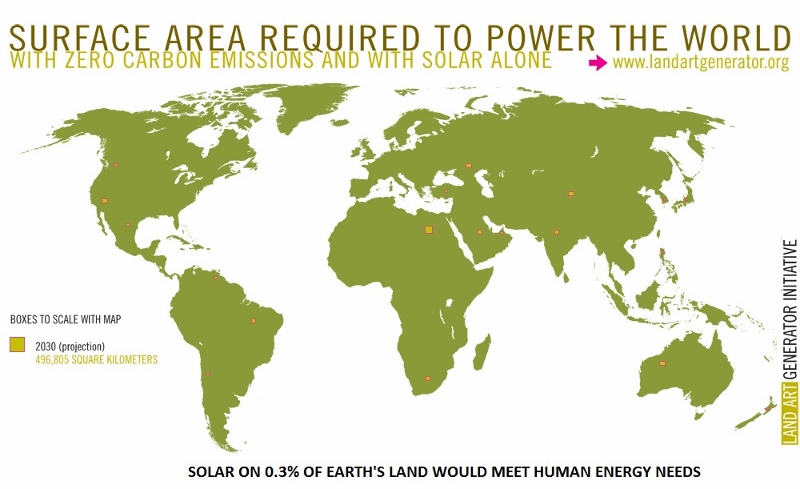
Only 0.3% of the Earth’s land area would be required to meet human energy needs with current efficiency solar panels. Image courtesy of landartgenerator.org
0.3% of the Earth’s land area is nothing to sneeze at. At the same time, it’s roughly 1/100th of the area that we use to grow crops and graze livestock. And it’s 1/60th of the area covered by the world’s deserts. With a small fraction of the planet’s deserts we could capture abundant energy to power the world.
The problems with renewable energy today have primarily been twofold: Cost and storage. Renewables have been far more expensive than fossil fuels. And they are intermittent, not always available when you need them (at night, for instance, or when the wind isn’t blowing). But both problems are solvable.
On the cost front, solar power is now approaching the price of grid electricity in the sunny parts of the world. It’s done this by plunging in cost over the last 30 years. A watt of solar power today costs just 1/20th of what it did in 1980, a staggering decline.
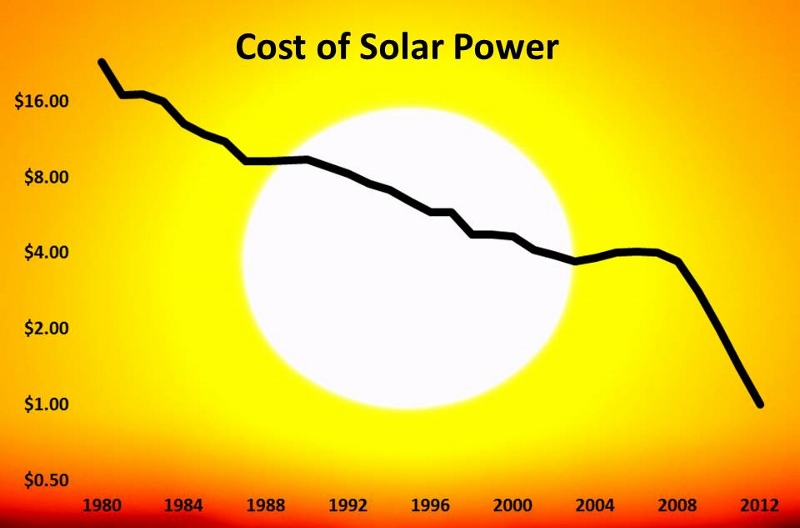
The cost of solar power has dropped by a factor of 20 over the last 33 years. Within the next 15 years, on current path, it will be cheaper than both coal and natural gas across most of the planet. Source: NREL Background Image: Ramez Naam
On current pace, by 2020 to 2025, solar power will be cheaper than electricity from coal or natural gas across the large majority of the planet, including China, India, and most of the developing world, where energy use is rising fastest.
Of course, past trends aren’t guarantees of future performance. To continue the cost plunge, we’ll need to innovate in the design and construction of solar modules, in new ways to deploy large solar arrays that cut deployment costs, in the cost of invertors (which convert DC solar electricity to AC grid electricity) and other equipment that must come with the core solar modules. Those advances are neither trivial nor guaranteed. They require a continued investment in R&D to achieve.
Nevertheless, there seem to be good odds that, within the next few decades, if not the next one decade, solar power will be capable of providing cheap, abundant, carbon-free electricity in a way that can be scaled around the world.
The second problem with renewables is storage. We use energy when the sun isn’t shining and when the wind isn’t blowing. Germany has demonstrated that renewables can provide up to about 40% of the electricity used in a power grid on their own. Beyond that, we need a large scale way to store the energy, and to keep the overall cost of renewables down, we need to store it cheaply. We also use energy in our vehicles, for which we need a way to store it densely — more stored energy in less mass. There’s a case to be made that today, storage is a bigger challenge than energy collection itself.
Fortunately, human ingenuity is dropping the price of batteries, as well, and increasing the amount of power that can be stored. Between 1991 and 2005, the price of storing a watt-hour of electricity in a lithium ion battery dropped by a factor of around 10, from $3.20 per watt hour to just over $0.30 per watt hour. In the same timeframe, the amount of energy that could be stored in lithium ion batteries of a given weight (their energy density) more than doubled, from under 90 watt hours per kilogram to more than 200 watt hours per kilogram.
That pace of improvement of both price and density is faster than the corresponding pace of improvement of solar and wind. In a typical 15- year period, the price of solar cells falls by around a factor of three, while the prices of batteries have fallen by around a factor of 10. If the learning curve of battery technologies can be maintained, the ability to store energy will advance faster than the ability to collect it, and overall prices will keep falling.
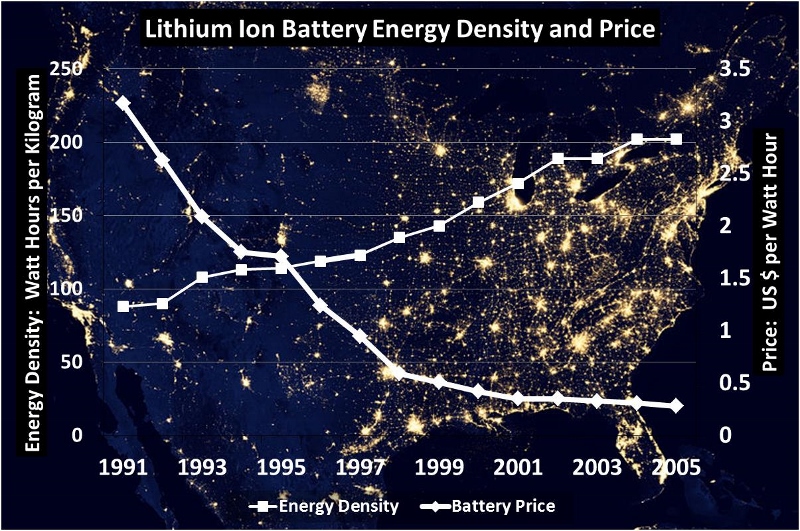
Between 1991 and 2005, the price of laptop batteries dropped by nearly 10x, and the amount of energy stored per weight more than doubled. Source: David Anderson and Dalia Patino-Echeverri, “An Evaluation of Current and Future Costs for Lithium-Ion Batteries for Use in Electrified Vehicle Powertrains.”
On the horizon are new battery technologies: solid state batteries (made like transistors) and metal-air batteries. At the upper end, metal-air batteriescould storemore than ten times the amount of energy that lithium-ion batteries do, and correspondingly drop the cost. That would give batteries an energy density similar to that of fossil fuels, meaning that electric vehicles (or even electric aircraft) with ranges similar to — or perhaps greater than — fossil fueled vehicles would be possible.
To be clear, there are substantial technical hurdles here too — metal-air batteries aren’t yet to the point that they can be charged and discharged the many thousands of times that a grid-scale or electric vehicle battery needs to be. But the basic physics and chemistry tell us that much higher energy densities than we see today are possible, and the long history of driving down the price of energy storage gives us reason to believe that it’s possible to keep doing so.
Energy, in short, is abundant. Carbon-free energy, the sort that would allow us to keep growing energy use while freeing ourselves from fossil fuels, is abundant. The problem isn’t solved, to be clear. Far from it. Huge challenges remain in innovating to bring the cost of renewables and storage down. Even then, deployment will be a gigantic undertaking. But the limiting factor on our use of clean energy – for the next few centuries, at least — isn’t the available resource. It’s our cleverness and ingenuity in learning to harness it cheaply and efficiently.
Growth Without Growth
I’ve focused the last few sections how large our ultimate physical resource base is. The ultimate supplies of energy, of potential food, and of potentially drinkable water for the planet are all hundreds of times greater than we can see humanity needing for the next century.
Yet if physical resource growth continues unabated, it will eventually consume any resource base, no matter how large. Could it be, though, that we can grow our economy and our well-being without growing our consumption of physical resources? There are reasons to think so.
Population:
Let’s start with population. Malthus thought of population growth as an exponential process, doomed to consume all available resources. And for quite some time, human population did grow exponentially. But those days appear to be over.
In Brazil, two generations ago, the average woman had 6 children over the course of her lifetime. Now, the average woman in Brazil has just 1.8 children over her lifetime. That number isn’t enough to even maintain the population. If fertility doesn’t rise, Brazil’s population will shrink over time.
Brazil is just one example. Everywhere that incomes rise, that education rises, and that women gain more opportunity outside of the home, fertility rates drop. European women now have around 1.5 children on average over the course of their lifetimes. Russian women are similar. South Korean women have only 1.3 children, on average, over the course of their lives.
Around the world as a whole, the average number of children a woman will have in her lifetime has dropped in half over the last 50-odd years, from 4.9 children per woman in 1960 to 2.5 children per woman around the world in 2011. When fertility drops below 2.1, population stops growing.
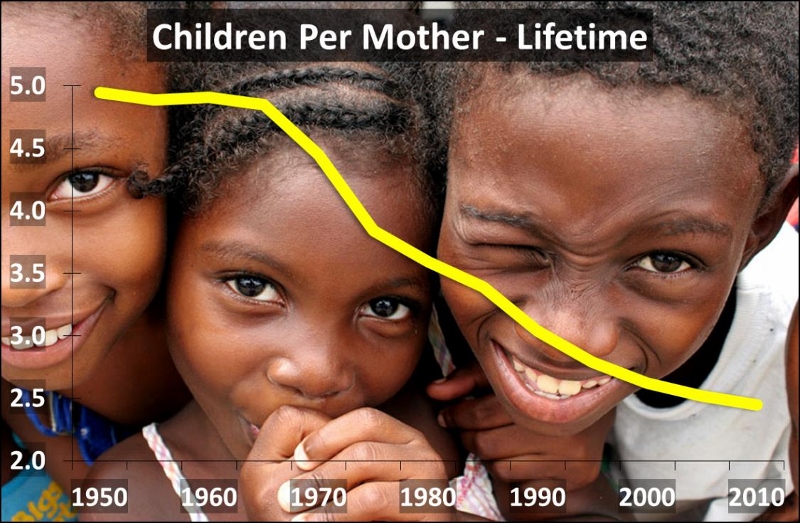
Around the world, the number of children born per woman over her lifetime has dropped from 5 in 1950 to less than 2.5 today. When the number drops near 2 in the coming decades, population will plateau. Source: World Bank. Background Image: Alejandra Quintero Sinisterra
As a result, between 2050 and 2100, something almost unprecedented in the history of the world is likely to occur. The world’s population is likely to plateau between 9 and 10 billion people. And after that, so long as wealth and education continue to rise, the world’s population is likely to drop.
The Great Decoupling
So population will reach a maximum. What of resource consumption per person? There, too, we see signs of a slowdown of growth, or in some cases, a complete halt to growth, or even a reduction in consumption.
Consider US oil consumption. While the average American consumed more than 30 barrels of oil a year in 1972, today he or she consumes only around 19 barrels of oil a year, and still dropping.
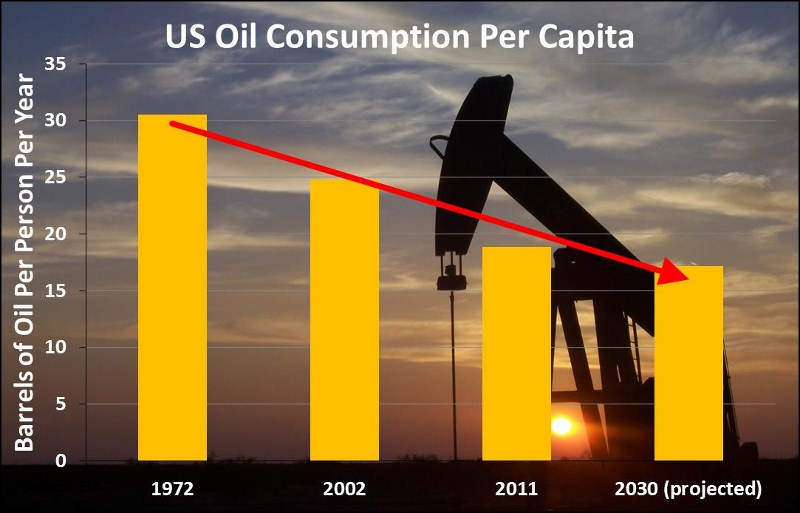
The average American uses a third less oil than in 1972. The International Energy Agency forecasts even further declines to come. Source: IEA.
Some of this is a shift away from oil and to other sources of energy. But summing up all energy sources combined, the average American uses slightly less energy than in the 1970s, even as per capita GDP has doubled, living area per person has nearly doubled, and life expectancy has risen by more than 8 years.
In fact, if we plot US GDP per person vs. US energy per person and US CO2 emissions per person, we see GDP (economic activity) pulling away from our use of energy and our CO2 emissions.
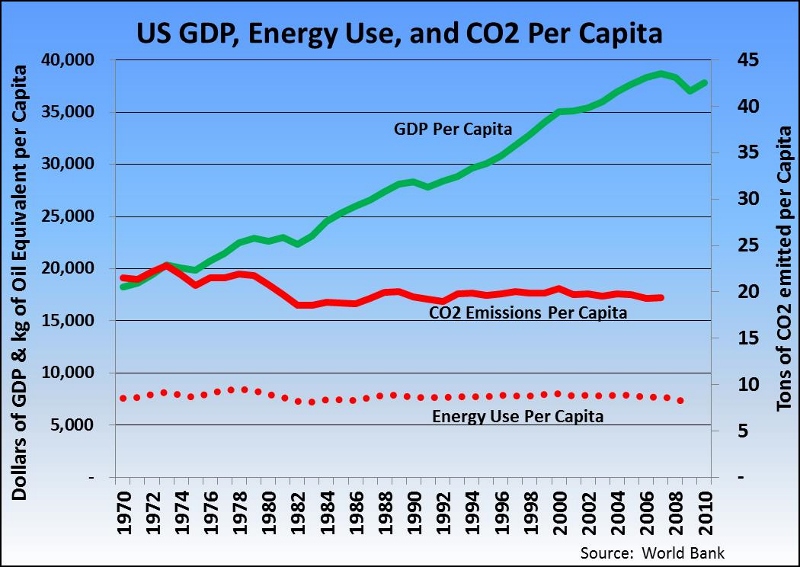
US GDP Per Capita has roughly doubled since 1970, while energy use and CO2 emissions per capita have dropped slightly. More wealth does not have to mean more consumption or more pollution. Source: World Bank.
Some will argue that this is a result of the US having outsourced energy US and CO2 emissions to other parts of the world (e.g., China). And that is partially true. Yet a look at the same numbers globally shows a similar pattern. CO2 emissions and energy use per capita are rising, but not nearly as quickly as GDP per capita.
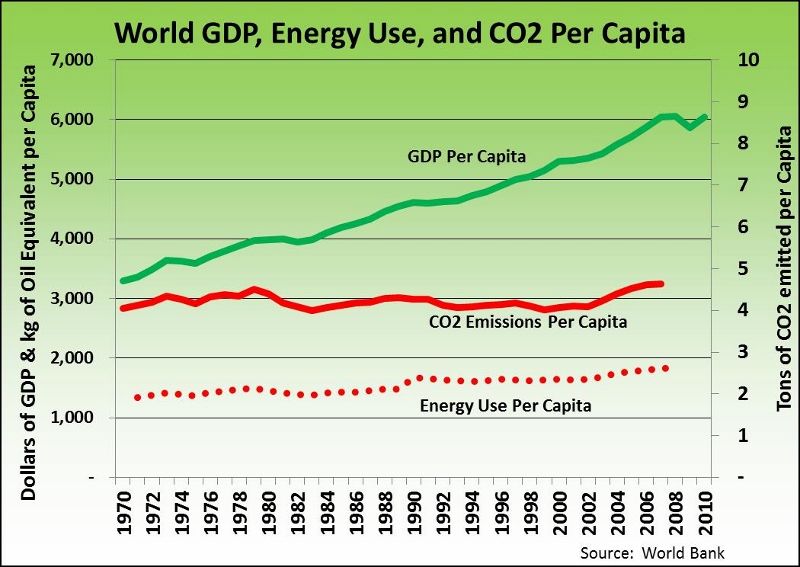
On a global scale, GDP is decoupling from energy use and CO2 emissions as well. Since 1970, GDP has grown at twice the rate of CO2 emissions, and 1.5x the rate of energy use. Source: World Bank.
Let’s be clear. This decoupling isn’t enough yet. Any rise in CO2 emissions per capita is problematic. We need a steep decrease in CO2 emissions. The above isn’t intended as a case that we’re on the right track yet — we’re not. It’s meant to illustrate something different: In principle, it’s possible to grow wealth and well-being without using more of a physical resource. The two can be decoupled. Now we need to accelerate the pace of that decoupling.
Turning the Corner
In some cases, we’ve actually gone beyond leaving consumption or pollution at a flatline, and have turned a corner. While growing an economy, we’ve shrunk the use of some resources, and the amounts of many types of pollution released.
Consider water use. In the United States, per capita water withdrawals rose from 1900 until the 1970s. But since then, they’ve dropped by more than a third:
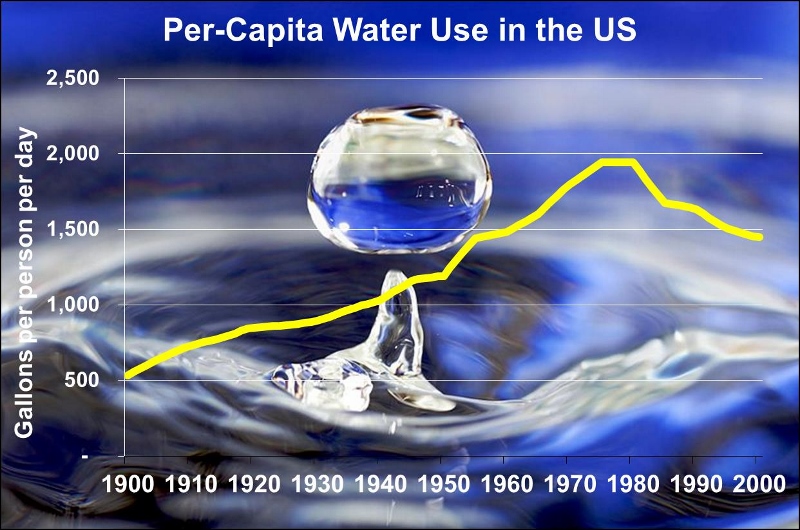
Water use per person in the United States peaked in the late 1970s and has declined ever since, largely due to more efficient agriculture. Source: Pacific Institute. Background image: José Manuel Suárez
That drop in water use has happened even as the US economy has roughly doubled in size and as US food production (the primary use of water) has also doubled. How? More efficient technology. We’ve increased crop yields by designing seeds that make better use of water and nutrients. We’ve shifted farm irrigation towards more and more efficient drip irrigation. We’ve increased the use of no-till farming, that dries out the soil less, conserving more of the water that’s there.
Again, this change isn’t yet enough. But it’s an indicator that we can grow wealth and grow output while shrinking consumption.
The same is even more true in pollution.
Emissions of sulfur dioxide, the chemical that causes acid rain, are less than half of what they were in 1970, and are down to levels not seen in the United States since 1910. Carbon monoxide emissions are down to half of what they were in 1970.
Mercury emissions have dropped by half since 1990. Lead concentrations in the atmosphere are just one tenth of what they were in 1980, and new emissions of lead have dropped to near zero. Emissions of particulates, PCBs, and nitrogen oxide are all down by roughly half. Worldwide emissions of ozone-destroying CFCs, once used as refrigerants, have plummeted to nearly zero. The Antarctic ozone hole is now recovering, ahead of schedule.
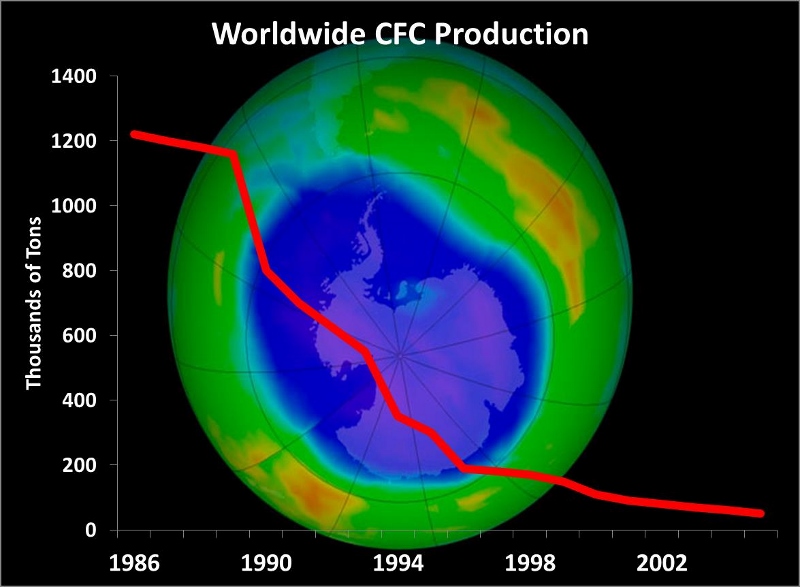
The world has driven the production of ozone-destroying CFCs down nearly to zero.Source: World Bank. Background Image: NASA.
The Limits to Growth model predicted that pollution would keep increasing so long as the world economy grew. The only way to reduce pollution was to reduce economic activity. But that isn’t what happened. Our cars and trucks haven’t stopped running. Their engines haven’t seized up. Our power plants have kept producing valuable electricity. And our refrigerators haven’t stopped working. In every case we’ve found a way to reduce the amount of a pollutant we emit, or to replace the substance with something more benign, without stopping industry or growth. Innovation has driven down pollution while our economy has grown.
That hasn’t happened on its own. The market has played a key role in each of those reductions of pollution, but it hasn’t been the driver. The driver has been our decision, collectively, to put restrictions on pollution levels. The US created laws to phase our lead and benzene, to reduce the emissions of acid-rain producing sulfur dioxide, and to control other pollutants. The world as a whole signed the Montreal Protocol to phase out CFCs and other compounds that were destroying the planet’s ozone layer.
Environmental concern is a phenomenon that tends to rise in a nation after a certain level of wealth. Still developing nations like China haven’t reached that point yet. Until recently, the environment has been a low priority. But with pollution there approaching levels nearly as bad as the US saw in the 70s, we can see the beginnings of a Chinese environmental movement that will likewise press for reduced pollution.
We still have miles to go in driving pollution lower, but the successes of the last decades demonstrate that pollution isn’t an inevitable side effect of economic growth. We can have more, while polluting less, and while consuming less.
Winning the Race
So we’re at a crucial point in human history — a race between destruction and creation. On the one side, we have the pace at which we’re consuming finite resources and warming and polluting the planet — a trend with disastrous consequences should it continue unchecked. On the other side, we have our vigorous progress in innovating to tap more efficiently and cleanly into a truly enormous supply of fundamental natural resources the planet provides.
Are we on track to win this race?
That’s not at all clear. Consider, for a moment, climate and energy. Multiple groups have proposed plans by which the world could be powered almost entirely by renewable energy by 2050, or, in the most ambitions plans, by 2030.
Yet even as those plans are articulated, worldwide CO2 emissions are rising, not falling. In 2012, the planet as a whole emitted a record-breaking 35.6 billion tons of CO2 into the atmosphere. And the concentration of greenhouse gases in the atmosphere is surging along with our annual emissions. In 2012, atmospheric CO2 concentrations rose by the largest amount in 15 years to a new level of 395 ppm, most of the way to the 450ppm that climate scientists have articulated as the threshold for dangerous warming.
The fundamental driver here is economics. Consumers, businesses, and industry want energy. They need energy. That’s true everywhere in the world. And they will buy whatever sort of energy is cheapest. Indeed, if a new source of energy is sufficiently cheaper than the old, consumers will switch their energy consumption from the old to the new.
If we want to win the race against climate change, one thing matters more than all others: make renewable energy (including storage) cheap. Dirt cheap. And do it fast.
How do we do that? Fundamentally, we need to increase the pace of innovation. And there are two clear strategies to do so.
The first is to invest more in clean energy R&D. In 2012, the US suffered $100 billion in damage from the climate-linked disasters of Hurricane Sandy and the still-ongoing drought. Yet we spent only $5 billion on clean energy R&D, an amount that’s roughly half of what we spent in the 1980s.
It’s also a small fraction of the $30 billion the US spends each year on medical research and the $80 billion the US spends each year on defense R&D. Yet in a very real sense, clean energy R&D is an investment in both future health and in national security. Bill Gates proposed last year that this amount should be roughly tripled to $16 billion. That’s a fine start.
The second is to be more inclusive in our cost accounting. The market is a brilliant algorithm that does a masterful job of allocating resources and driving incentives — so long as costs are fully transparent to it. But sometimes, a cost is completely missing from the books — missing in such a way that the market can’t see it.
Fossil fuels have substantial side effects that those who burn them aren’t charged for. The damage done to the environment — and thus, to others — is a cost that society pays, which isn’t passed on to the polluter. That cost is high. Peer-reviewed research suggests that every ton of CO2 emitted inflicts somewhere between $55 and $250 of damage on the environment and others.
Because that cost isn’t passed on as part of the price of fossil fuel use, the market misbehaves. The overall cost of coal, natural gas, and oil is higher than the price paid at the pump or on the power bill. But the part that’s missing is being inflicted on others, spread out over billions of people on the planet, and smeared out over years to come.
Those sorts of costs that are handed off to third parties are called externalities. They’re external to the transaction happening between between buyer and seller. Because the market doesn’t see those costs, it can’t work to minimize them on its own. The whole history of environmental regulation is one of controlling such externalities. We’ve done that by imposing hard limits on the amount of pollution that can be produced.
We’ve also done it by charging a price for pollution — attempting to insert that externality cost back into the transaction. That technique — a price for polluting — was a key part of both the reduction in acid-rain producing sulfur dioxide in the United States, and also in the efforts that drove down CFC emissions around the world and prevented further damage to the ozone layer.
A price on greenhouse emissions — a carbon price, if you will — would spur both conservation and innovation. Because fossil fuel use would be higher, consumers and businesses would be incented to use less fossil fuels, to opt for higher efficiency, and to switch to lower carbon sources of energy.
But even more importantly, a carbon price would accelerate innovation in renewable energy and energy storage. How? More customers purchasing wind or solar power and the batteries that will go with them means more dollars going into the industry. That allows renewable energy manufacturers to build larger factories, which get better economies of scale in producing solar panels and wind turbines.
It also provides those companies with more dollars to invest into research and development of their own. And it makes the industry more attractive for early stage investors looking to back revolutionary new ideas in renewable energy.
By driving the cost of renewable energy down, a carbon price has a global effect — those cheaper renewable energy sources become more attractive to consumers around the world, whether their own country has a carbon price or not.
I’ve focused here primarily on climate, because it’s the threat that touches all others. But similar approaches apply to food, to water, and to fish in the ocean. In all of those cases, there’s room for substantially higher federal R&D — to invest in crops that have higher yields, particularly for the developing world; to develop new low-cost ways to cut water usage in farming; and to put more sensible prices and restrictions on the over-fishing of deep ocean fish, and thus accelerate the shift to sustainable fish farming.
Easy Way or Hard Way?
Ultimately, there are two paths forward for us, the easy way and the hard way.
In the easy way, we acknowledge the evidence that we are causing real harm to our planet, leaving it worse off for future generations, and flirting with the possibility of sudden and dramatic consequences. We retain our optimism, that we can both address these problems and be far richer in the future than we are today. We take our wildly successful economic system and we fix it so that it recognizes the value of our shared resources and encourages their protection, restoration, and careful, efficient, sustainable use. We invest in action to reduce the risk of even worse future disasters caused by our unwise past. Nothing is certain in life. But on that path, the most likely outcome is that we’ll solve the problems that plague us and grow progressively richer even as we reduce and eventually reverse our negative impact on the planet.
On this path, there’s no sign that economic growth needs to end. There’s no sign that we’re anywhere near the wealth limit of this planet. We have sufficient energy, sufficient water, and the capacity to grow sufficient food to provide 9 or 10 billion people with a level of affluence far beyond what even the richest in the world enjoy today.
The other path, the hard way, isn’t so pleasant. On that path, we continue to deny the damage we’re doing, the very real consequences, and the risk of much worse if we continue along this path. We keep on acting in the way we have, pumping carbon into the atmosphere, warming the planet, acidifying the oceans, hunting fish towards the brink of extinction, depleting the last fossil water buried under our lands. On that path, we’ll eventually come to realize that we’ve made a mistake. When the rivers and wells run dry, when we can no longer find the type of fish we used to eat, when the corals we used to admire have all bleached, when droughts and floods and storms wreck our cities and fields, then we’ll realize that we’ve taken the wrong path.
And then we’ll respond.
I’m an optimist. I believe in humanity’s ingenuity. Even on the path of the hard way, I think we’ll prevail. We’ll scramble and find solutions. Yet the cost will be far higher a decade or two from now than it would be if we started today. And the scars will run deeper, in species lost, in acidified seas, in forests chopped or burned down, in climate-created famines and pestilence, in wars and conflicts born of resource scarcity.
Or perhaps I’m wrong, and on that hard path we simply won’t respond in time, in the way that other cultures of the past failed to respond to the disasters that ultimately led to their collapse. It’s not a chance any of us should be eager to take.
Easy way or hard way. The choice is ours.
For more elaboration on the argument above, see The Infinite Resource: The Power of Ideas on a Finite Planet.
References and Further Reading
A long list of citations for both parts of this series is available in the references to book, from which the series is adapted.
Many of the references listed in Part One are just as relevant for understanding the solutions to our problems as the problems themselves.
To these, some good additions are below:
On the potential of renewable energy (including solar) to power the world, see:
– IPCC, Special Report on Renewable Energy Sources and Climate Change Mitigation
– National Renewable Energy Laboratory, Renewable Electricity Futures Report
– National Renewable Energy Laboratory, Transportation Energy Futures
On desalination technology past and future trends, an excellent summary is found in Menachem and Elimelech, “The Future of Seawater Desalination”, Science (2011)
On fresh water depletion: Pacific Institute, The Worlds Water, Vol. 7
On climate change: Intergovernmental Panel on Climate Change, IPCC Fourth Assessment Report: Climate Change 2007 (AR4)
On feeding the world and the ultimate limits of global food yields, see:
– Food and Agriculture Organization of the UN, How to Feed the World in 2050
– International Food Research Institute, Biophysical Limits to Global Food Production
Data on population growth rates and on GDP, energy use, and CO2 emissions per capita are all drawn from the World Bank, Data Bank of Development Indicators
Much more is found within the book.
Originally posted at Scientific American.